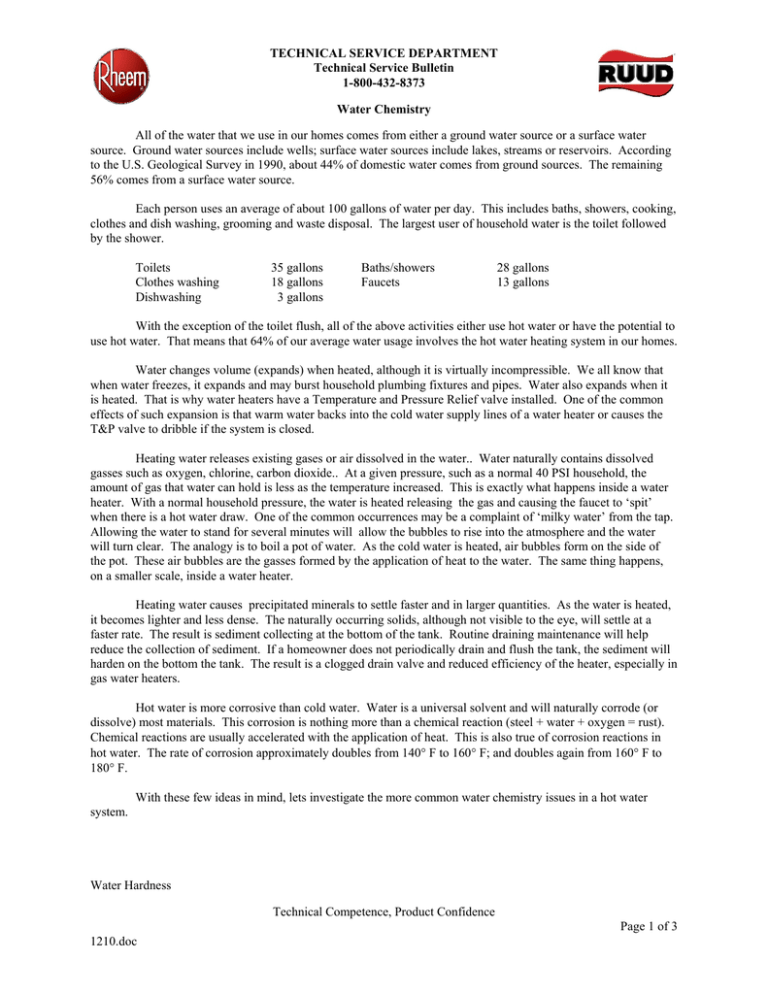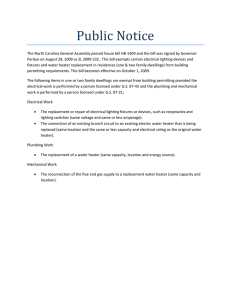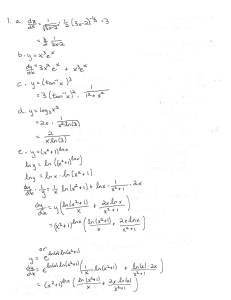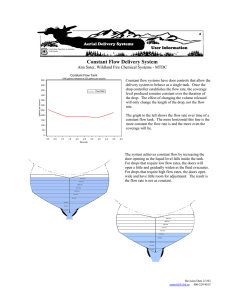TECHNICAL SERVICE DEPARTMENT Technical Service
advertisement

TECHNICAL SERVICE DEPARTMENT Technical Service Bulletin 1-800-432-8373 Water Chemistry All of the water that we use in our homes comes from either a ground water source or a surface water source. Ground water sources include wells; surface water sources include lakes, streams or reservoirs. According to the U.S. Geological Survey in 1990, about 44% of domestic water comes from ground sources. The remaining 56% comes from a surface water source. Each person uses an average of about 100 gallons of water per day. This includes baths, showers, cooking, clothes and dish washing, grooming and waste disposal. The largest user of household water is the toilet followed by the shower. Toilets Clothes washing Dishwashing 35 gallons 18 gallons 3 gallons Baths/showers Faucets 28 gallons 13 gallons With the exception of the toilet flush, all of the above activities either use hot water or have the potential to use hot water. That means that 64% of our average water usage involves the hot water heating system in our homes. Water changes volume (expands) when heated, although it is virtually incompressible. We all know that when water freezes, it expands and may burst household plumbing fixtures and pipes. Water also expands when it is heated. That is why water heaters have a Temperature and Pressure Relief valve installed. One of the common effects of such expansion is that warm water backs into the cold water supply lines of a water heater or causes the T&P valve to dribble if the system is closed. Heating water releases existing gases or air dissolved in the water.. Water naturally contains dissolved gasses such as oxygen, chlorine, carbon dioxide.. At a given pressure, such as a normal 40 PSI household, the amount of gas that water can hold is less as the temperature increased. This is exactly what happens inside a water heater. With a normal household pressure, the water is heated releasing the gas and causing the faucet to ‘spit’ when there is a hot water draw. One of the common occurrences may be a complaint of ‘milky water’ from the tap. Allowing the water to stand for several minutes will allow the bubbles to rise into the atmosphere and the water will turn clear. The analogy is to boil a pot of water. As the cold water is heated, air bubbles form on the side of the pot. These air bubbles are the gasses formed by the application of heat to the water. The same thing happens, on a smaller scale, inside a water heater. Heating water causes precipitated minerals to settle faster and in larger quantities. As the water is heated, it becomes lighter and less dense. The naturally occurring solids, although not visible to the eye, will settle at a faster rate. The result is sediment collecting at the bottom of the tank. Routine draining maintenance will help reduce the collection of sediment. If a homeowner does not periodically drain and flush the tank, the sediment will harden on the bottom the tank. The result is a clogged drain valve and reduced efficiency of the heater, especially in gas water heaters. Hot water is more corrosive than cold water. Water is a universal solvent and will naturally corrode (or dissolve) most materials. This corrosion is nothing more than a chemical reaction (steel + water + oxygen = rust). Chemical reactions are usually accelerated with the application of heat. This is also true of corrosion reactions in hot water. The rate of corrosion approximately doubles from 140° F to 160° F; and doubles again from 160° F to 180° F. With these few ideas in mind, lets investigate the more common water chemistry issues in a hot water system. Water Hardness Technical Competence, Product Confidence Page 1 of 3 1210.doc TECHNICAL SERVICE DEPARTMENT Technical Service Bulletin 1-800-432-8373 Water Chemistry Hard water is found in more than 85% of the United States. Water hardness is due to the presence of two dissolved minerals - calcium and magnesium. So common are these two minerals in water that practically no supply can be found that does not contain at least one or two grains per gallon. Mineral concentrations may be expressed as grains per gallon or parts per million. When you have high levels of calcium and magnesium in your water more scrubbing power and more detergent is required to clean and wash clothing. The following are some of the tell-tale signs of hard water: Difficult to remove soap scum on tubs, showers, basins and faucet fixtures. Reduced sudsing and cleaning capabilities of some soaps and detergents. Scale build up around faucet fixtures and on the inside of a water heater Scale build up is one of the most serious problems caused by hard water mineral deposits. These deposits, commonly called lime build up, may clog water pipes, collect in the bottom of water heaters and collect on electrical heating elements immersed inside the water heater. The build up on the electrical heating elements will insulate the elements and reduce their efficiency. Eventually, the elements will fail. If this sediment is allowed to remain in the tank, it will gradually sink to the bottom where it will harden into an insoluble scale. This will lead to a reduction in the efficiency of the gas water heater, clogging of the drain valve and may lead to eventual tank failure. Hydrogen Sulfide Hydrogen sulfide (H2S) is a gas present in some waters. There is never any doubt when it is present due to its offensive ‘“rotten egg” odor in concentrations as low as one part per million. Hydrogen sulfide is present in the incoming cold water supply and normally found only in ground water. There are several preconditions that must be present before the odor becomes noticeable. First, there must be a moderate to high sulfate content in the water supply. This is most common in well water . The water supply to the home lacks sufficiently high chlorine to kill the bacteria. The water heater is allowed to stand (stagnate) for as little as 8-12 hours. Finally, the occurrence of this odor is more prevalent in water softener systems that use an ion exchange process to remove calcium and magnesium and substitute sodium. This favorable condition is enhanced with the application of heat, such as in a hot water heater. The smell is most noticeable with the first hot water draw in the morning or maybe when you get home from work. Iron Iron is a common element in nature. It is not surprising that most surface or ground water contains some iron. Natural iron usually occurs as an insoluble oxide, but the ground water recharge process collects iron in a soluble form that is dissolved in water. At concentrations of 0.3 parts per million or greater, iron can produce brown or red stains on plumbing fixtures, laundry or masonry surfaces. In higher concentrations, it can produce an unpleasant metallic taste in the water. Iron can also produce favorable conditions for the growth of “iron bacteria”. Left untreated, these bacteria results in a jelly-like slimy mass. This mass can cause clogged pipes and filter screens and produce a foul tasting water. Other indications of the presence of iron are: At levels above 0.3 PPM, water drawn from a faucet appears clear, but when allowed to stand takes on a yellowish tint. Water appears rusty or has a red or yellow color when drawn from a faucet. Slimy brown or red film in plumbing fixtures, especially inside a toilet tank. Manganese Technical Competence, Product Confidence Page 2 of 3 1210.doc TECHNICAL SERVICE DEPARTMENT Technical Service Bulletin 1-800-432-8373 Water Chemistry Manganese is rarely found alone in a water source, but is usually paired with iron. At concentrations of 0.05 parts per million, manganese can cause black staining of fixtures, laundry or masonry. Deposits of manganese can collect in plumbing systems and produce a dark brown or black sediment and black turbidity (suspension of particles) in the water. Like iron, manganese can also produce an environment that supports the growth of “manganese bacteria” and clog screens and plumbing lines. Together with iron, manganese bacteria cause a general deterioration or water quality by creating taste, odor and staining problems. Technical Competence, Product Confidence Page 3 of 3 1210.doc




